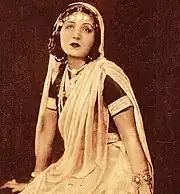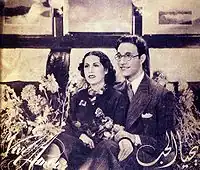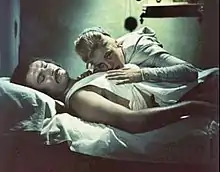| Egyptian cinema | |
|---|---|
 | |
| No. of screens | 221 (2015)[1] |
| • Per capita | 0.4 per 100,000 (2010)[1] |
| Main distributors | The Trinity: (Nasr – Oscar – El Massah) Cinema Masr Sphinix Studio Masr[2] |
| Produced feature films (2005–2009)[3] | |
| Total | 42 (average) |
| Number of admissions (2015)[4] | |
| Total | 9,561,000 |
| Gross box office (2015)[4] | |
| Total | $267 million |
The cinema of Egypt refers to the flourishing film industry based in Cairo, sometimes also referred to as Hollywood of the East or Hollywood on the Nile.[5] Since 1976, the capital has held the annual Cairo International Film Festival, which has been accredited by the FIAPF.[6] There are an additional 12 festivals. Of the more than 4,000 short and feature-length films made in MENA region since 1908, more than three-quarters were Egyptian films.[7][8][9] Egyptian films are typically spoken in the Egyptian Arabic dialect.
History
Beginnings


| This article is part of a series on |
| Life in Egypt |
|---|
 |
| Culture |
| Society |
| Politics |
| Economy |
|
Egypt portal |
A limited number of silent films were made in Egypt beginning in 1896; 1927's Laila was notable as the first full-length feature. Cairo's film industry became a regional force with the coming of sound. Between 1930 and 1936, various small studios produced at least 44 feature films. In 1936, Studio Misr, financed by industrialist Talaat Harb, emerged as the leading Egyptian equivalent to Hollywood's major studios, a role the company retained for three decades.[10]
Historians disagree in determining the beginning of cinema in Egypt. Some say in 1896, when the first film was watched in Egypt, while others date the beginning from 20 June 1907 with a short documentary film about the visit of Khedive Abbas Hilmi II to the Institute of Mursi Abul-Abbas in Alexandria. In 1917, the director Mohammed Karim established a production company in Alexandria. The company produced two films: Dead Flowers and Honor the Bedouin, which were shown in the city of Alexandria in early 1918. Years later, Aziza Amir produced Laila (1927), the first feature-length Egyptian film in history.[11]
Since then, more than 4,000 films have been produced in Egypt, three quarters of the total Arab production. Historian Samir Kassir notes (2004) that Studio Misr in particular, "despite their ups and downs, were to make Cairo the third capital of the world’s film industry, after Hollywood and Bombay but ahead of Italy’s Cinecittà."[12] Egypt is the most productive country in the Middle East and Africa in the field of film production, and the one with the most developed media system.[13]
The Golden Age
The 1940s, 1950s and the 1960s are generally considered the Golden Age of Egyptian cinema. In the 1950s, Egypt's cinema industry was the world's third largest.[14] As in the West, films responded to the popular imagination, with most falling into predictable genres (happy endings being the norm), and many actors making careers out of playing strongly typed parts. In the words of one critic, "If an Egyptian film intended for popular audiences lacked any of these prerequisites, it constituted a betrayal of the unwritten contract with the spectator, the results of which would manifest themselves in the box office."[15]
In 1940,[16] the entrepreneur and translator Anis Ebeid established "Anis Ebeid Films", as the first subtitling company in Egypt and the rest of the Middle East, bringing hundreds of American and World movies to Egypt. Later he entered the movie distribution business too.[17]
In 1950, Studio Misr produced the film Baba Aris, the first Egyptian film entirely in natural color, starring Naima Akef, Fouad Shafik, Camelia, and Shoukry Sarhan. In 1951, Mohamed Fawzi experimented with coloring two of his films: Love in Danger and The End of a Story. Unfortunately, the two films burned on their way from France to Egypt, and the black-and-white copies remained on Egyptian television.[18] It was said that Mohamed Fawzi was not satisfied with the quality. The colors in the first film were poor, so he had to re-shoot it, which caused him huge financial losses. In 1956, the film Dalila was produced in Scope colours, starring Abdel Halim Hafez and Shadia. Afterwards, many Egyptian-colored Egyptian films were produced on a limited basis in the 1950s and 1960s, and in the 1970s, specifically after the 1973 October War, colors became prevalent in most films.
Currently, ancient Egyptian classic films, in addition to the latest cinematic productions, are shown on private Arab channels, some of which are "free viewing" that can be benefited from through promotional segments or advertisements, and some of them are for a fee through the pay-per-view service on closed networks. Political changes in Egypt after the overthrow of King Farouk in 1952 initially had little effect on Egyptian film. The Nasser regime sought control over the industry only after turning to socialism in 1961.[19]
In the 1960s, the General Cinema Foundation was established to produce feature films, which is affiliated with the public sector in Egypt. This led to a decrease in the average number of films from 60 to 40 films per year, and by 1966 the number of theaters also decreased from 354 in 1954 to 255 houses. By 1966, the Egyptian film industry had been nationalized. As with all matters in that period, diametrical opinions can be found about the cinema industry then. In the words of Ahmed Ramzi, a leading man of the era, "it went to the dogs".[20] In this era, an emerging generation of film stars came to prominence such as: Shoukry Sarhan, Soad Hosny, Salah Zulfikar, Rushdy Abaza, Nadia Lutfi, Faten Hamama, Omar Sharif, Kamal El-Shennawi, Shadia, Mariam Fakhr Eddine, Lobna Abdel Aziz, Abdel Halim Hafez, Huda Sultan, Hind Rostom, Farid Shawqi, Zubaida Tharwat, Ismail Yassine, Magda, Laila Fawzi, Ahmed Mazhar, and Sabah.

Egyptian films shown in the 1960s can be divided into three sections: films that deal with the subject of poverty, raising the value of work, and praising socialist society, such as the film Soft Hands directed by Mahmoud Zulfikar, films that condemned opportunistic models and social diseases such as bribery, corruption, and theft crimes, such as Miramar, and films that dealt with issues of people's political participation, condemned negativity, and also addressed topics of democracy, connection to the land, and resistance, such as the film The Rains Dried. The "heavy government hand" that accompanied nationalization of Egyptian film "stifled innovative trends and sapped its dynamism".[21] However, most of the 44 Egyptian films featuring in the best 100 Egyptian films list of all time were produced during that period. Notable titles includes; The Night of Counting the Years, Aghla Min Hayati, Cairo Station, The Second Man, My Wife, the Director General, Saladin the Victorious, A Taste of Fear, The Postman, Back Again, Soft Hands, and The Land.
By the 1970s, Egyptian films struck a balance between politics and entertainment. Films such as 1972's Khalli Balak min Zouzou (Watch Out for ZouZou), starring "the Cinderella of Arab cinema", Soad Hosny, sought to balance politics and audience appeal. Zouzou integrated music, dance, and contemporary fashions into a story that balanced campus ferment with family melodrama. In mid-1971, the General Cinema Foundation was liquidated and a public body was established that included cinema, theater and music. The Authority stopped film production, contenting itself with financing the private sector, and the state's role in cinema began to decline until it completely ended novel production. Only two companies remained with the state, one for studios and the other for distribution and theaters. However, the average number of films produced remained 40 films until 1974, then it rose to 50. films, and the number of theaters continued to decline until it reached 190 in 1977. Notable 1970s titles include; Sunset and Sunrise, Chitchat on the Nile, The Other Man, The Bullet is Still in My Pocket, Karnak, The Guilty, I Want a Solution, Whom Should We Shoot?, Alexandria... Why?, Shafika and Metwali.[22] Hassan Ramzi's 1975 Egyptian film Al-Rida’ al-Abyad (The White Gown) was released in the Soviet Union in 1976, selling 61 million tickets in the country. This made it the highest-grossing foreign film of the year and the seventh highest-grossing foreign film ever in the Soviet Union.[23][24] This also made it the highest-grossing Egyptian film of all time, with its Soviet ticket sales surpassing the worldwide ticket sales of all other Egyptian films, achieving revenue over $28,700,000 in 1975.[25]
Transitional period

The 1980s saw the Egyptian film industry in decline, however, the industry saw huge box-office jumps. A new wave of young directors emerged who were able to overcome the prevailing production traditions and create serious cinema. They were called the Neo-Realism Movement or the generation of the eighties. From this generation were Atef El Tayeb, Khairy Beshara, Mohamed Khan, Raafat Al-Mihi Ali Abdelkhalek and others. Also, a new generation of films stars such as: Ahmed Zaki, Nour El-Sherif, Adel Imam, Mahmoud Abdel Aziz, Nabila Ebeid, Nadia El Gendy, Yousra, Laila Elwi, Elham Shahin, and Sherihan, emerged during that period. In the 1980s, Egyptian cinema produced notable films, such as; The Shame, An Egyptian Story, The Bus Driver, The Peacock, The Innocent, The Collar and the Bracelet, A Moment of Weakness, The Wife of an Important Man, and Escape. In the mid-eighties, specifically at the beginning of 1984, the number of films produced suddenly increased to 63 films.
In the 1990s, However, with the rise of what came to be called "contractor movies". Actor Khaled El Sawy has described these as films "where there is no story, no acting and no production quality of any kind... basic formula movies that aimed at making a quick buck." the number of films produced also declined: from nearly 100 films a year in the industry's prime to about a dozen in 1995. This lasted until summer 1997, when Ismailia Rayeh Gayy (translation: Ismailia back and forth) shocked the cinema industry, enjoying unparalleled success and large profits for the producers, introducing Mohamed Fouad (a famous singer) and Mohamed Henedi, then a rather unknown actor who later became the number one comedian star. Building on the success of that movie, several comedy films were released in the following years. The 1990s notable titles include; the industry presented notable films such as; Alexandria Again and Forever, War in the Land of Egypt, The Kit Kat, The Shepherd and the Women, Terrorism and Kebab, The Terrorist, Five-Star Thieves, Road to Eilat, The Emigrant, Nasser 56, Destiny, Land of Fear, and The City.
Present

Since mid 1990s, Egypt's cinema has gone in separate directions. Smaller art films attract some international attention, but sparse attendance at home. Popular films, often broad comedies such as What A Lie!, and the extremely profitable works of comedian Mohamed Saad, battle to hold audiences either drawn to Western films or, increasingly, wary of the perceived immorality of film.[19]
With the beginning of the 21st century, a new generation of film stars appeared, the most famous of whom were Mona Zaki, Ahmed El Sakka, Menna Shalabi, Karim Abdel Aziz, Hend Sabry, Ghada Adel, Ahmed Ezz, Ahmed Helmy, Yasmine Abdulaziz, Mohamed Henedi, Mohamed Saad, Tamer Hosny, Mai Ezz Eldin, Nour, Hany Ramzy, Nelly Karim, Basma, and Dalia El Behery. They starred in many films and were able to achieve success and fame within a short period of time during that period. A few productions, such as 2003's Sleepless Nights, intertwined stories of four bourgeois couples[26] and 2006's Imarat Yacoubian (The Yacoubian Building) bridge this divide through their combination of high artistic quality and popular appeal.
In 2006, the film Leisure Time was released. A social commentary on the decline of Egyptian youth, the film was produced on a low budget and had attendant low production values. The film, however, became a success. Its controversial subject matter, namely, the sexual undertones in today's society, was seen as confirmation that the industry was beginning to take risks. A major challenge facing Egyptian and international scholars, students and fans of Egyptian film is the lack of resources in terms of published works, preserved and available copies of the films themselves, and development in Egypt of state and private institutions dedicated to the study and preservation of film. The Egyptian National Film Centre (ENFC), which theoretically holds copies of all films made after 1961, is according to one Egyptian film researcher, "far from being a library, houses piles of rusty cans containing positive copies."[27]The year 2007, however, saw a considerable spike in the number of Egyptian films made. In 1997, the number of Egyptian feature-length films created was 16; 10 years later, that number had risen to 40. Box office records have also risen significantly, as Egyptian films earned around $50 million.[28][29]
In the 2010s new films stars entered the Egyptian box, such as: Ahmed Mekky, Ruby, Asser Yassin, Donia Samir Ghanem, Amina Khalil, Ahmed El-Fishawy, Mohamed Emam, Yasmin Raeis, Amr Saad, Hana El Zahed, Bayoumi Fouad, Maged El Kedwany, Amir Karara, Yasmine Sabri, Mohamed Ramadan, Dina El Sherbiny, Hesham Maged, Shiko, and Ahmed Fahmy. There are notable films released in this period, such as; 678, Microphone, Asmaa, The Deal, Decor, Bebo and Beshir, The Blue elephant, Excuse My French, Hepta, Gunshot, X-Large, Papa, After the Battle, Diamond Dust, The Blue elephant 2, The Treasure, Sons of Rizk, The Originals, The Treasure 2, Sheikh Jackson, Casablanca, Sons of Rizk 2, 122, The Crime and others.[30] During Eid al-Fitr (which is the season of new films in Egypt) for the year 2016, several films were shown in Egyptian theaters, many of them comedies, namely: Crash, Hell in India, Abu Shanab. The film 30 Years Ago was also shown, which is an action and drama film starring a large number of Egyptian artists, including: Ahmed El Sakka, Mona Zaki, Mervat Amin, Sherif Mounir, Nour in the starring roles. In 2017, many films were shown, including: The Cell, Ali, the Goat and Ibrahim, Emergency escape, Brooks, Meadows and Lovely Faces, Lucky Bank, and others.[31]
Festivals
Since 1952, Cairo has held The Catholic Center film festival. It is the oldest film festival in the Middle East and Africa. It is specialized in Egyptian Cinema. Since 1976, Cairo has held the annual Cairo International Film Festival, which has been accredited by the International Federation of Film Producers Associations.[6] Other film festivals are held in Egypt including:
- Luxor African Film Festival
- Aswan International Women's Film Festival
- Cairo International Women's Film Festival
- Alexandria International Film Festival
- El Gouna Film Festival
- Cairo Cinema Days
- National Egyptian Film Festival
- Cairo Francophone Film Festival
- Catholic Center Film Festival
- Port Said Festival for Arab Films
- Film Association Festival for Egyptian Cinema
- Sharm El-Sheikh Film Festival
- Ismailia International Film Festival for Documentaries and Shorts
Notable films
Cinema of Egypt |
|---|
| List of Egyptian films |
| Pre 1920 |
| 1920s |
|
1920 1921 1922 1923 1924 1925 1926 1927 1928 1929 |
| 1930s |
|
1930 1931 1932 1933 1934 1935 1936 1937 1938 1939 |
| 1940s |
|
1940 1941 1942 1943 1944 1945 1946 1947 1948 1949 |
| 1950s |
|
1950 1951 1952 1953 1954 1955 1956 1957 1958 1959 |
| 1960s |
|
1960 1961 1962 1963 1964 1965 1966 1967 1968 1969 |
| 1970s |
|
1970 1971 1972 1973 1974 1975 1976 1977 1978 1979 |
| 1980s |
|
1980 1981 1982 1983 1984 1985 1986 1987 1988 1989 |
| 1990s |
|
1990 1991 1992 1993 1994 1995 1996 1997 1998 1999 |
| 2000s |
|
2000 2001 2002 2003 2004 2005 2006 2007 2008 2009 |
| 2010s |
|
2010 2011 2012 2013 2014 2015 2016 2017 2018 2019 |
| 2020s |
| 2020 2021 2022 2023 2024 |
Notable figures
Directors
- Ahmed Badrakhan (1909–1969)
- Anwar Wagdi (1904–1955)
- Atef El Tayeb (1947–1995)
- Daoud Abdel Sayed (1946–)
- Ezz El-Dine Zulficar (1919–1963)
- Hassan el-Imam (1919–1988)
- Henry Barakat (1912–1997)
- Hussein Kamal (1932–2003)
- Karim Diaa El-Din (1946–2021)
- Khairy Beshara (1947–)
- Maher Sabry (1967–)
- Mahmoud Zulfikar (1914–1970)
- Marwan Hamed (1970–)
- Mohamed Khan (1942–2016)
- Mohammed Karim (1896–1972)
- Salah Abu Seif (1915–1996)
- Shady Abdel Salam (1930–1986)
- Sherif Arafa (1960–)
- Tamer El Said (1972–)
- Yousry Nasrallah (1952–)
- Youssef Chahine (1926–2008)
- Youssef Wahbi (1898–1982)
Cinematographers
- Wahid Farid (1919–1998)
- Tarek El-Telmissany (1950–)
Actors and actresses
- Abdelhalim Hafez (El Andaleeb) (1929–1977)
- Adel Emam (1940–)
- Ahmed El Sakka (1973–)
- Ahmed Ezz (1971–)
- Ahmed Helmy (1969–)
- Ahmed Mazhar (1917–2002)
- Ahmad Zaki (1949–2005)
- Amina Rizk (1910–2003)
- Anwar Wagdi (1904–1955)
- Elham Shahin (1961–)
- Emad Hamdy (1909–1984)
- Ezzat El Alaili (1934–2021)
- Ezz El-Dine Zulficar (1919–1963)
- Farid al-Atrash (1915–1974)
- Farid Shawky (1920–1998)
- Farouk al-Fishawy (1952–2019)
- Faten Hamama (1931–2015)
- Fuad Al Mohandes (El Ostaz) (1924–2006)
- Hend Rostom (1929–2011)
- Hussein El Imam (1951–2014)
- Hussein Fahmy (1940–)
- Ismail Yasin (1912–1972)
- Khaled Abol Naga (1966–)
- Laila Elwi (1962–)
- Layla Murad (1918–1995)
- Laila Taher (1942–)
- Lebleba (1945–)
- Madiha Yousri (1921–2018)
- Magda (1931–2020)
- Mahmoud Abdel Aziz (1946–2016)
- Mahmoud Yassin (1941–2020)
- Mahmoud Zulfikar (1914–1970)
- Mariam Fakhr Eddine (1933–2014)
- Mary Queeny (1913–2003)
- Mervat Amin (1946–)
- Mohamed Abdel Wahab (1902–1991)
- Mohamed Henedi (1965–)
- Mona Zaki (1976–)
- Mounira El Mahdeya (1885–1965)
- Nabila Ebeid (1945–)
- Nadia Al-Gindi (1946–)
- Nadia Lutfi (1937–2020)
- Nagat El-Sagheera (1938–)
- Naglaa Fathi (1951–)
- Naguib Al Rihani (1889–1949)
- Naima Akef (1932–1966)
- Nelly Mazloum (1929–2003)
- Nour El-Sherif (1946–2015)
- Omar Sharif (1932–2015)
- Poussi (1953–)
- Rushdy Abaza (1926–1980)
- Sabah (1921–2014)
- Safia El Emari (1949–)
- Salah Zulfikar (1926–1993)
- Samia Gamal (1924–1994)
- Samir Ghanem (1937–2021)
- Sanaa Gamil (1932–2002)
- Shadia (1929–2017)
- Shukry Sarhan (1925–1997)
- Shwikar (1939–2020)
- Soad Hosny (1943–2001)
- Soher El Bably (1937–)
- Tahiya Carioca (1920–1999)
- Youssef Wahbi (1898–1982)
- Yousuf Shaaban (1931–2021)
- Yousra (1955–)
- Zaki Rostom (1903–1972)
Film critics
- Samir Farid (1943–2017)
- Tarek El Shennawi
Music Composers
- Ammar El Sherei (1948–2012)
- Ali Ismael (1922–1974)
- Fouad Al-Zahery (1916–1988)
- Moody El Imam (1957–present)
- Omar Khairat (1948–present)
- Rageh Daoud (1954–present)
- Hesham Nazih (1972–present)
See also
In the press
References
- 1 2 "Table 8: Cinema Infrastructure – Capacity". UNESCO Institute for Statistics. Archived from the original on 24 December 2018. Retrieved 5 November 2013.
- ↑ "Table 6: Share of Top 3 distributors (Excel)". UNESCO Institute for Statistics. Archived from the original on 24 December 2018. Retrieved 5 November 2013.
- ↑ "Average national film production". UNESCO Institute for Statistics. Archived from the original on 25 December 2018. Retrieved 5 November 2013.
- 1 2 "Table 11: Exhibition – Admissions & Gross Box Office (GBO)". UNESCO Institute for Statistics. Archived from the original on 25 December 2018. Retrieved 4 December 2017.
- ↑ "Egyptian Cinema: Hollywood on the Nile – Oxford Islamic Studies Online". www.oxfordislamicstudies.com. Retrieved 2022-01-29.
- 1 2 Cairo Film Festival information Archived 2011-12-08 at the Wayback Machine.
- ↑ Shafik, Viola (2007). Popular Egyptian Cinema: Gender, Class, and Nation. Oxford University Press. ISBN 978-977-416-053-0.
- ↑ Houissa, Ali. "LibGuides: Middle Eastern & North African Cinema & Film: Egyptian Cinema & Film". guides.library.cornell.edu. Retrieved 2022-01-29.
- ↑ "The golden age of Egyptian cinema – Focus – Al-Ahram Weekly". Ahram Online. Retrieved 2022-01-29.
- ↑ Darwish, Mustafa, Dream Makers on the Nile: A Portrait of Egyptian Cinema, The American University in Cairo Press, Cairo, 1998, Pp. 12–13.
- ↑ "The Egyptian Women as a cinematic figure and her status in Film industry since 1920 and till now". wlahawogohokhra.com. 2019-02-13. Retrieved 2023-11-27.
- ↑ Kassir, Samir (2013). Being Arab. Verso. ISBN 978-1-84467-280-6. OCLC 866820842.
- ↑ "The golden age of Egyptian cinema - Focus - Al-Ahram Weekly". Ahram Online. Retrieved 2022-01-29.
- ↑ A.V. "The rise and fall of Egyptian Arabic". The Economist. Retrieved 1 February 2018.
- ↑ Farid, Samir, "Lights, camera...retrospection" Archived 2013-05-11 at the Wayback Machine, Al-Ahram Weekly, December 30, 1999
- ↑ "LAFF – History of Cinema: Egypt". Archived from the original on 2013-09-24. Retrieved 2013-09-24.
- ↑ "Untitled Document". Archived from the original on 2013-09-28. Retrieved 2013-09-24.
- ↑ السينما المصرية المعاصرة وتحولاتها في السنوات العشر الأخيرة: مجموعة أبحاث (in Arabic). المجلس الأعلى للثقافة،. 2008. ISBN 978-977-437-661-0.
- 1 2 Farid, Samir, "An Egyptian Story" Archived 2013-05-14 at the Wayback Machine, Al-Ahram Weekly, November 23–29, 2006
- ↑ Khairy, Khaireya, "Ahmed Ramzi: rendezvous at the snooker club" Archived 2007-04-12 at the Wayback Machine, Al-Ahram Weekly, June 22, 2000
- ↑ Farid, Samir, "Lights, camera... retrospection" Al-Ahram Weekly, December 30, 1999
- ↑ Anis, Mouna, "Before the public gaze" Archived 2003-05-10 at the Wayback Machine, Al-Ahram Weekly, June 28, 2001
- ↑ Sergey Kudryavtsev (4 July 2006). "Зарубежные фильмы в советском кинопрокате". LiveJournal (in Russian).
- ↑ "«Белое платье» (Al-Reda' Al-Abiad, 1973)". KinoPoisk (in Russian). Retrieved 25 May 2020.
- ↑ "Советский кинопрокат – Империя наносит ответный удар". Krasnoyeznamya.ru (in Russian). Archived from the original on 13 May 2014. Retrieved 25 May 2020.
- ↑ "Sahar el Layali", The New York Times, 2004
- ↑ El-Assyouti, Mohamed, "Forgotten memories" Archived 2013-05-13 at the Wayback Machine,Al-Ahram Weekly, September 2, 1999
- ↑ "«2007»: صعود وهبوط في السينما المصرية ... ومفاجآت كبيرة وطفرة في الإنتاج". «2007»: صعود وهبوط في السينما المصرية ... ومفاجآت كبيرة وطفرة في الإنتاج. 2008-01-02. Retrieved 2023-10-29.
- ↑ "What are the 10 highest-grossing movies in the history of Egyptian cinema?". EgyptToday. 2019-11-08. Retrieved 2023-10-29.
- ↑ "The Best Egyptian Films of the 2010s | Egyptian Streets". 2019-12-26. Retrieved 2023-10-29.
- ↑ Rashed, Mohamed (2019-12-22). "Our Picks for the Top 10 Egyptian Movies of the Decade!". Scoop Empire. Retrieved 2023-10-29.
- ↑ "Abi foq al-Shagara". 17 February 1969 – via www.imdb.com.
- ↑ "Afarit el-asphalt". 11 August 1996 – via www.imdb.com.
- ↑ "Ali Baba and the Forty Thieves" – via www.imdb.com.
- ↑ "Date Wine". 1 September 1999 – via www.imdb.com.
- ↑ "Land of Fear". 14 March 2007 – via www.imdb.com.
- ↑ "The Land". 4 August 2012 – via www.imdb.com.
- ↑ "Al-asfour". 28 October 2007 – via www.imdb.com.
- ↑ "Awdat al ibn al dal". 5 August 2012 – via www.imdb.com.
- ↑ "Sons of Egypt" – via www.imdb.com.
- ↑ "The Will". 6 November 1939 – via www.imdb.com.
- ↑ "El Medina". 5 July 2000 – via www.imdb.com.
- ↑ "The Two Orphans" – via www.imdb.com.
- ↑ "Al-yawm al-Sadis". 3 December 1986 – via www.imdb.com.
- ↑ "A Happy Day" – via www.imdb.com.
- ↑ "Yom mor... yom helw" – via www.imdb.com.
- ↑ "Zeinab". 18 May 2018 – via www.imdb.com.
Further reading
- Viola Shafik, Popular Egyptian Cinema: Gender, Class, and Nation, American University in Cairo Press, 2007, ISBN 978-977-416-053-0
- Walter Armbrust, "Political Film in Egypt" in: Josef Gugler (ed.) Film in the Middle East and North Africa: Creative Dissidence, University of Texas Press and American University in Cairo Press, 2011, ISBN 978-0-292-72327-6, ISBN 978-9-774-16424-8, pp 228–251
External links
- African Media Program Comprehensive database of African media
- El-Cinema.com (an IMDb inspired Egyptian/Arabic movie database)
